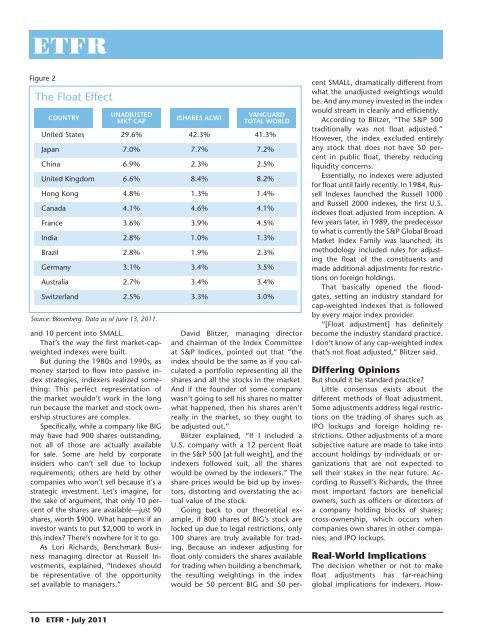US-Listed ETFs Sorted by Asset Class and Year-to-Date Return
US-Listed ETFs Sorted by Asset Class and Year-to-Date Return
US-Listed ETFs Sorted by Asset Class and Year-to-Date Return
You also want an ePaper? Increase the reach of your titles
YUMPU automatically turns print PDFs into web optimized ePapers that Google loves.
Figure 2<br />
The Float Effect<br />
COUNTRY<br />
UNADJ<strong>US</strong>TED<br />
MKT CAP<br />
United States 29.6% 42.3% 41.3%<br />
Japan 7.0% 7.7% 7.2%<br />
China 6.9% 2.3% 2.5%<br />
United Kingdom 6.6% 8.4% 8.2%<br />
Hong Kong 4.8% 1.3% 1.4%<br />
Canada 4.1% 4.6% 4.1%<br />
France 3.6% 3.9% 4.5%<br />
India 2.8% 1.0% 1.3%<br />
Brazil 2.8% 1.9% 2.3%<br />
Germany 3.1% 3.4% 3.5%<br />
Australia 2.7% 3.4% 3.4%<br />
Switzerl<strong>and</strong> 2.5% 3.3% 3.0%<br />
Source: Bloomberg. Data as of June 13, 2011.<br />
<strong>and</strong> 10 percent in<strong>to</strong> SMALL.<br />
That’s the way the first market-capweighted<br />
indexes were built.<br />
But during the 1980s <strong>and</strong> 1990s, as<br />
money started <strong>to</strong> flow in<strong>to</strong> passive index<br />
strategies, indexers realized something:<br />
This perfect representation of<br />
the market wouldn’t work in the long<br />
run because the market <strong>and</strong> s<strong>to</strong>ck ownership<br />
structures are complex.<br />
Specifically, while a company like BIG<br />
may have had 900 shares outst<strong>and</strong>ing,<br />
not all of those are actually available<br />
for sale. Some are held <strong>by</strong> corporate<br />
insiders who can’t sell due <strong>to</strong> lockup<br />
requirements; others are held <strong>by</strong> other<br />
companies who won’t sell because it’s a<br />
strategic investment. Let’s imagine, for<br />
the sake of argument, that only 10 percent<br />
of the shares are available—just 90<br />
shares, worth $900. What happens if an<br />
inves<strong>to</strong>r wants <strong>to</strong> put $2,000 <strong>to</strong> work in<br />
this index? There’s nowhere for it <strong>to</strong> go.<br />
As Lori Richards, Benchmark Business<br />
managing direc<strong>to</strong>r at Russell Investments,<br />
explained, “Indexes should<br />
be representative of the opportunity<br />
set available <strong>to</strong> managers.”<br />
ISHARES ACWI<br />
VANGUARD<br />
TOTAL WORLD<br />
David Blitzer, managing direc<strong>to</strong>r<br />
<strong>and</strong> chairman of the Index Committee<br />
at S&P Indices, pointed out that “the<br />
index should be the same as if you calculated<br />
a portfolio representing all the<br />
shares <strong>and</strong> all the s<strong>to</strong>cks in the market.<br />
And if the founder of some company<br />
wasn’t going <strong>to</strong> sell his shares no matter<br />
what happened, then his shares aren’t<br />
really in the market, so they ought <strong>to</strong><br />
be adjusted out.”<br />
Blitzer explained, “If I included a<br />
U.S. company with a 12 percent float<br />
in the S&P 500 [at full weight], <strong>and</strong> the<br />
indexers followed suit, all the shares<br />
would be owned <strong>by</strong> the indexers.” The<br />
share prices would be bid up <strong>by</strong> inves<strong>to</strong>rs,<br />
dis<strong>to</strong>rting <strong>and</strong> overstating the actual<br />
value of the s<strong>to</strong>ck.<br />
Going back <strong>to</strong> our theoretical example,<br />
if 800 shares of BIG’s s<strong>to</strong>ck are<br />
locked up due <strong>to</strong> legal restrictions, only<br />
100 shares are truly available for trading.<br />
Because an indexer adjusting for<br />
float only considers the shares available<br />
for trading when building a benchmark,<br />
the resulting weightings in the index<br />
would be 50 percent BIG <strong>and</strong> 50 percent<br />
SMALL, dramatically different from<br />
what the unadjusted weightings would<br />
be. And any money invested in the index<br />
would stream in cleanly <strong>and</strong> efficiently.<br />
According <strong>to</strong> Blitzer, “The S&P 500<br />
traditionally was not float adjusted.”<br />
However, the index excluded entirely<br />
any s<strong>to</strong>ck that does not have 50 percent<br />
in public float, there<strong>by</strong> reducing<br />
liquidity concerns.<br />
Essentially, no indexes were adjusted<br />
for float until fairly recently. In 1984, Russell<br />
Indexes launched the Russell 1000<br />
<strong>and</strong> Russell 2000 indexes, the first U.S.<br />
indexes float adjusted from inception. A<br />
few years later, in 1989, the predecessor<br />
<strong>to</strong> what is currently the S&P Global Broad<br />
Market Index Family was launched; its<br />
methodology included rules for adjusting<br />
the float of the constituents <strong>and</strong><br />
made additional adjustments for restrictions<br />
on foreign holdings.<br />
That basically opened the floodgates,<br />
setting an industry st<strong>and</strong>ard for<br />
cap-weighted indexes that is followed<br />
<strong>by</strong> every major index provider.<br />
“[Float adjustment] has definitely<br />
become the industry st<strong>and</strong>ard practice.<br />
I don’t know of any cap-weighted index<br />
that’s not float adjusted,” Blitzer said.<br />
Differing Opinions<br />
But should it be st<strong>and</strong>ard practice?<br />
Little consensus exists about the<br />
different methods of float adjustment.<br />
Some adjustments address legal restrictions<br />
on the trading of shares such as<br />
IPO lockups <strong>and</strong> foreign holding restrictions.<br />
Other adjustments of a more<br />
subjective nature are made <strong>to</strong> take in<strong>to</strong><br />
account holdings <strong>by</strong> individuals or organizations<br />
that are not expected <strong>to</strong><br />
sell their stakes in the near future. According<br />
<strong>to</strong> Russell’s Richards, the three<br />
most important fac<strong>to</strong>rs are beneficial<br />
owners, such as officers or direc<strong>to</strong>rs of<br />
a company holding blocks of shares;<br />
cross-ownership, which occurs when<br />
companies own shares in other companies;<br />
<strong>and</strong> IPO lockups.<br />
Real-World Implications<br />
The decision whether or not <strong>to</strong> make<br />
float adjustments has far-reaching<br />
global implications for indexers. How-<br />
10 ETFR • July 2011
















